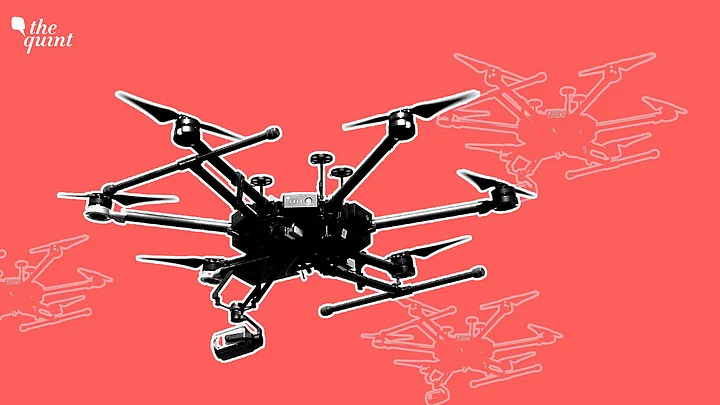The Indian Armed Forces were prepared when Pakistan unleashed a wave of drones across the northern and western sectors post Operation Sindoor on 7 May. The element of surprise, if any, had been lost long since Turkish drone makers advertised their sales to Pakistan—and one of them, Baykar, which manufactures Bayraktar TB2 unmanned aerial vehicles (UAVs), said in 2022 that it would never sell the fire-and-forget machines to India.
The air defence shield created by the three wings of the Indian military is one of the surprises of the four-day conflict to—not just to Pakistan but to China as well.
Most of the 400-odd Turkish and Chinese drones coming from Pakistan were shot down—and the few that escaped did little damage.
A lesser-known fact is the effective use of drones by India during raids on Pakistan's 11 different air bases. The homemade BrahMos missiles were immediately followed by drones to take advantage of the confusion and cause more damage, informed sources said.
Several small Indian companies have contributed by making small-winged drones that often escape radars—and prove to be very effective in a conflict scenario.
India has been reluctant to target the civilian population, a moral high point, but one that gives Pakistani fighters an edge. The four-day altercation showed that Pakistan was using drones to target the civilian population in the border areas of Jammu and Kashmir, Punjab, and Rajasthan. This forced Indian forces to use up precious interceptor missiles to protect the local population, purportedly reducing its inventory.
The Need to Build Homemade Drones, Defence Systems
One of the takeaways from the recent hostilities between India and Pakistan is the need to invest heavily on locally manufacturing drones and air defence systems, including interceptors, in a big way.
Military drones are unmanned and low-cost flying machines, making it easy to use them in big numbers without the fear of losing lives and suffering heavy losses. Certain types of drones are so cheap that 1,000 of them can be bought for the price of one bomber jet.
A good example of drone production is the SkyStriker drones manufactured in a joint venture between Bengaluru-based Alpha Design Technologies and Israel's defense contractor Elbit Systems.
India currently uses UAVs manufactured by publicly owned Hindustan Aeronautics Ltd (HAL), those imported from Israel and the US, as well as some made by smaller Indian companies. Major Indian companies—from Reliance, Tata, Adani, and Mahindra, who have stepped into defence production—should look for joint ventures with Israeli and other foreign manufacturers.
34 Years of Changing Warfare Systems
Drones, also called UAVs or Remotely Piloted Vehicles (RPVs), have been changing warfare systems since they were first used in a significant manner by the US military in the 1990-91 war in Kuwait.
It has been 34 years since unmanned drones displayed their ability to work in all segments—the army, the air force, and the navy.
For example, a tank or a field gun can hit targets up to a few kms. But even a small drone can fly 15-20 kms before dropping grenades and bombs. A laptop or iPad-wielding pilot is often in a better position to hit targets using maps, satellite images, and ground intelligence reports.
UAVs used for spy and suicide missions that drop firepower before destroying themselves can cost very little, sometimes equal to the price of a medium-range car. A bomber jet can often cost as much as $1 billion, an amount enough to buy 1,000 powerful, wide-winged RPVs.
But uniformed men in different countries are still unable to wean themselves away from their facilitation for direct gun-to-gun or plane-to-plane wars.
Manufacturers of traditional expensive military hardware like expensive tanks and bomber jets have a stronger voice because of their lobby groups and connections with governments in the US, Europe, and other places in the world.
India uses an effective spy drone, Israel’s IAI Heron, which is a Medium Altitude Long Endurance (MALE) machine, according to various media reports. Another Israeli craft is a suicide vehicle, IAI Harop, which acts as a loitering munition dropping hellfire before destroying itself.
Pakistan's UAV Power
If Pakistan—with its weak economy and low technology base—has been able to manufacture drones indigenously, India should be able to do much more. One of Pakistan’s indigenously produced UAVs is NESCOM Burraq, which is capable of carrying laser-guided missiles for precision strikes. It has also produced GIDS Shahpar—a MALE UAV developed by Global Industrial and Defence Solutions in collaboration with NESCOM, a Pakistani funded defence contractor.
Pakistan’s UAV power needs to be examined carefully because two countries, China and Turkey, have assured it with a continuous supply, even though Islamabad has no funds to pay for them.
They include China’s CH-4, a MALE armed drone that can carry air-to-surface missiles and precision-guided bombs. Pakistan is believed to operate a number of these UAVs.
It also uses a significant number of Wing Loong II, another advanced Chinese MALE armed drone with a larger payload capacity than the CH-4, according to reports.
Turkey, on the other hand, has provided Pakistan with Bayraktar TB2, a tactical armed drone that has proved its efficacy in various conflicts. Pakistan also uses another Turkish drone, Asisguard Songar, which is a smaller, tactical armed drone equipped with an automatic machine gun or grenade launcher.
Pakistan has purportedly used these Turkish drones in the recent cross-border conflict.
(Saibal Dasgupta has been a foreign correspondent for 18 years and has authored Running with the Dragon: How India Should Do Business with China. This is an opinion piece, and the views expressed are the author’s own. The Quint neither endorses nor is responsible for them.)
